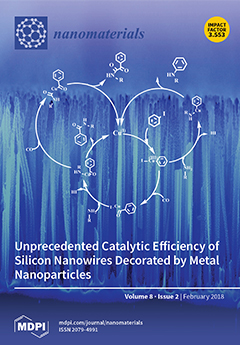Open AccessArticle
Electrochemical Preparation of Polyaniline Nanowires with the Used Electrolyte Solution Treated with the Extraction Process and Their Electrochemical Performance
by
Ying Wu 1,2,3,4, Jixiao Wang 1,2,3,4,*, Bin Ou 1,2,3,4, Song Zhao 1,2,3,4, Zhi Wang 1,2,3,4 and Shichang Wang 1,2,3,4
1
Clean Energy Research Center, School of Chemical Engineering and Technology, Tianjin University, Tianjin 300354, China
2
Tianjin Key Laboratory of Membrane Science and Desalination Technology, Tianjin University, Tianjin 300354, China
3
State Key Laboratory of Chemical Engineering, Tianjin University, Tianjin 300354, China
4
Collaborative Innovation Center of Chemical Science and Engineering (Tianjin), Tianjin University, Tianjin 300354, China
Cited by 11 | Viewed by 5003
Abstract
Electrochemical polymerization of aniline is one of the most promising methods to prepare polyaniline (PANI) materials. However, during this process, the electrolyte solution must be replaced after electropolymerization of a certain time because of the generation and the accumulation of the by-products, which
[...] Read more.
Electrochemical polymerization of aniline is one of the most promising methods to prepare polyaniline (PANI) materials. However, during this process, the electrolyte solution must be replaced after electropolymerization of a certain time because of the generation and the accumulation of the by-products, which have significant effects on the morphology, purity and properties of PANI products. Treatment and recycling of the used electrolyte solution are worthwhile to study to reduce the high treatment cost of the used electrolyte solution containing aniline and its polymerization by-products. Here, the composition of the used electrolyte solution was separated and determined by high performance liquid chromatography coupled with diode array detection (HPLC-DAD) in the range of ultraviolet and visible (UV-Vis) light. The analysis results revealed that the used electrolyte solution consisted of aniline, p-hydroquinone (HQ), p-benzoquinone (BQ), co-oligomers of aniline and p-benzoquinone (CAB) and acid. Then, n-octanol and 2-octanone were selected as extracts to remove HQ, BQ and CAB from the used electrolyte solution. Following that, the recycled electrolyte solution was prepared by adjusting the concentration of aniline and acid of the aqueous phase, and the electrochemical polymerization process was conducted. Finally, the obtained PANI was characterized by scanning electron microscope (SEM) and electrochemical methods. The experimental results clearly demonstrate that the morphology and specific capacitance of PANI produced from the recycled electrolyte solution can be recovered completely. This research paves the way for reusing the used electrolyte solution for aniline electrochemical polymerization.
Full article
►▼
Show Figures






